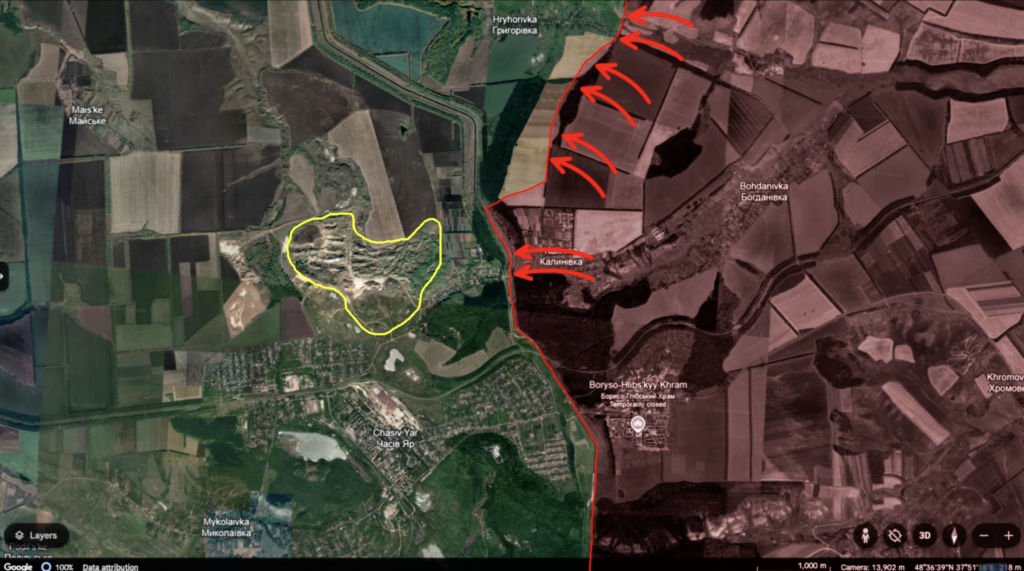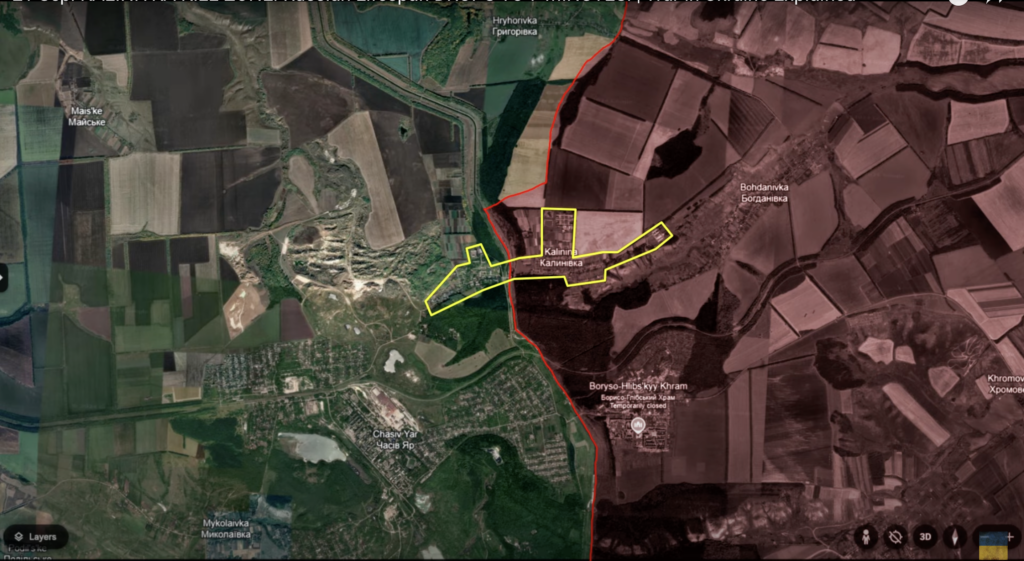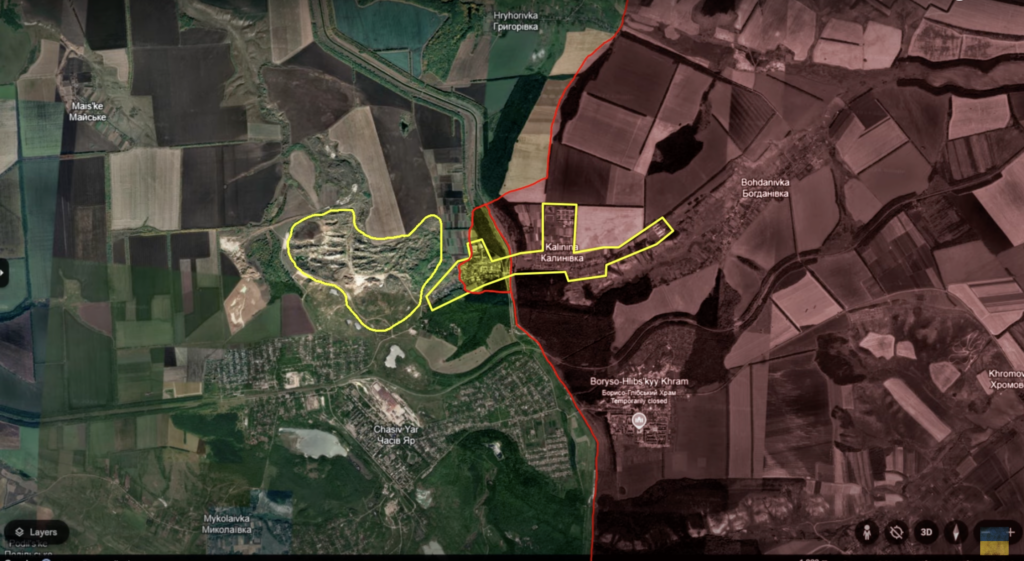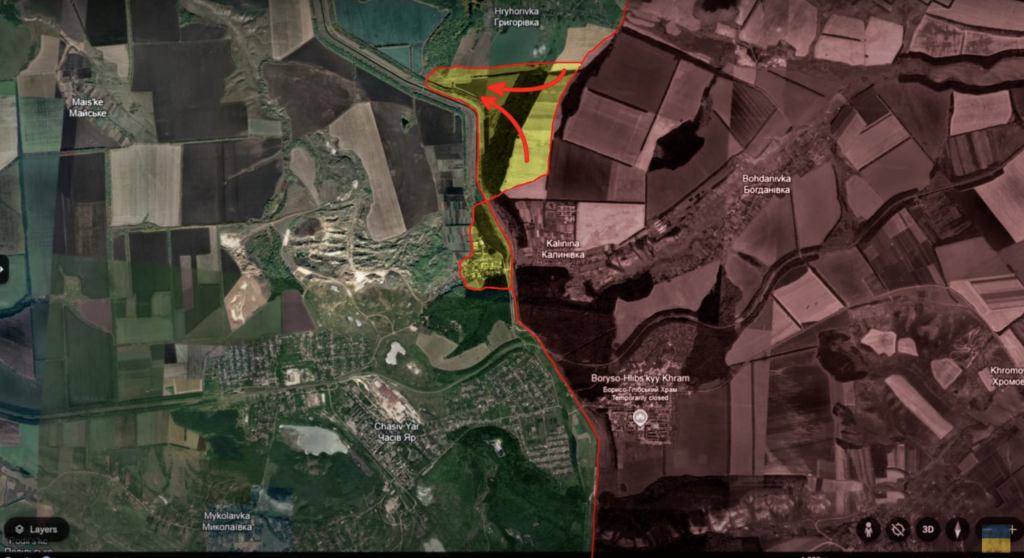Frontline report: Russian troops resume offensive near Bakhmut, but their advance halted
Russian forces are attempting to seize control of a coal mine complex north of Chasiv Yar, which sits at a higher elevation and would provide critical fire control over the entire area. Ukrainian defenders are racing to reinforce the site as Russians struggle to make headway.


Today, there is a lot of important news from Bakhmut.
Here, the Russians renewed their offensive effort after a month of pause to approach Chasiv Yar from the north by taking the northern coal mine. The fighting around the town intensified once again, as Ukrainians are effectively localizing the Russian breakthough attempts near Kalinivka, effectively creating a deadly fire pocket just several hundred meters in depth.
Previously, Russian forces focused on consolidating their control over the eastern side of the canal near Hryhorivka, while simultaneously attempting to cross the canal and secure full control of Kalinivka.
Paratroopers from the 98th Airborne Division, assigned to this sector, paused their operations for an extended period to recover from previous losses, with some elements redeployed to the Kursk region. After replenishing their ranks and stabilizing other fronts, the Russian command resumed offensive operations in the Chasiv Yar area.
The Russian command centered their offensive strategy around the town of Kalinivka, located north of Chasiv Yar. To advance, Russian forces need to cross the canal running through Kalinivka, which divides the town into eastern and western parts.
Securing positions on the western side of the town would provide the Russians with a crucial staging ground to launch an assault on the northern coal mine complex near Chasiv Yar, a key tactical high ground. If we look at the topographic map, we can see that the northern coal mine sits at a slightly higher elevation than Chasiv Yar itself, giving it strategic importance in the area.
By seizing control of the northern coal mine complex, Russian forces would be able to exploit its elevated heaps to establish fire control over the entire Chasiv Yar area. These commanding positions would allow them to monitor Ukrainian troop movements within and around Chasiv Yar, providing critical intelligence for their aviation and artillery units.

Additionally, the elevated heaps could serve as ideal spots for mortar and sniper positions, enabling rapid strikes against Ukrainian forces in the town. If the Russians successfully consolidate their hold on the northern coal mine and fully utilize its high ground for fire control, they would be positioned to launch a direct assault on the center of Chasiv Yar, potentially jeopardizing the Ukrainian defense of the city.
The Russian command implemented this plan by launching an assault on Kalinivka, following heavy shelling and bombardment of the village. With a significant number of paratroopers replenished after a month-long pause, they were able to sustain intense, high-casualty attacks.
Their objective was to swiftly capture all of Kalinivka and then immediately move on to assault the northern coal mine complex. However, despite an initial push, the Russian advance stalled after covering less than five hundred meters west of Kalinivka.

Once the Russian advance and rapid maneuvers stalled, Ukrainian forces found it easier to track and target Russian troops attempting to take cover in Kalinivka’s apartment buildings. Despite this, the Russian command continued sending reinforcements to the Kalinivka bridgehead, hoping to amass a stronger assault force for a renewed attack on the northern coal mine from within the town.
However, the Russian bridgehead, covering only about 100 square meters, became highly vulnerable. This small area made it easy for Ukrainian forces to detect large concentrations of Russian troops, turning it into a kill zone where they inflicted heavy losses.
Combat footage from the area shows the Ukrainian Air Force bombing Russian positions in Kalinivka with GBU-39 guided bombs, effectively suppressing the troops and halting further assaults.
Additionally, Ukrainian drone operators targeted Russian TOS thermobaric artillery systems, which are crucial for supporting ground offensives. In a significant blow to Russian forces, they successfully destroyed a rare TOS thermobaric system, reducing the fire support available to Russian units and weakening their assault capabilities.
As a result of the failure to expand from the precarious bridgehead in Kalinivka, the Russian command redirected their offensive efforts toward Hryhorivka.

They utilized their aviation to suppress Ukrainian positions around the village in preparation for securing ground near the canal. Following intense air strikes, Russian forces launched a series of assaults, ultimately capturing strategically significant Ukrainian trenches situated on higher ground next to the canal.
However, even if the Russians managed to take Kalinivka, it is unlikely they would achieve substantial progress toward the northern coal mine. They still face the obstacle of crossing the canal from this direction and more than 2 km of open fields in the lowlands north of the coal mine complex present a formidable challenge, making meaningful gains difficult.
Overall, the Russians initiated assault in the Bakhmut direction after a month-long operational pause, only for the operations to fall short of the initial Russian goals and hold powerful Ukrainian-guided bomb and drone strikes after they contained their advance in a kill zone.
This development forced the Russians to switch their focus to Hryhorivka to the North in an effort that is even less likely to achieve the goal of taking the heights of coal mine complex.
This development will enable the Ukrainians to reinforce the defenses of the mine itself and deploy additional reinforcements to the area in time to more effectively respond to future Russian assaults around the town until the Russian paratroopers exhaust their reserves.
In our regular frontline report, we pair up with the military blogger Reporting from Ukraine to keep you informed about what is happening on the battlefield in the Russo-Ukrainian war.



